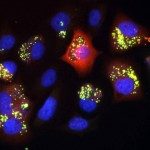Link to Pubmed [PMID] – 17926642
Antivir. Ther. (Lond.) 2007;12(6):877-88
BACKGROUND: Human herpesvirus 6 (HHV-6), which is closely related to human cytomegalovirus, is sensitive to foscarnet (PFA). Up to now, the resistance of HHV-6 to PFA has not been investigated.
OBJECTIVES: The goal of the study was to isolate and characterize PFA-resistant HHV-6 mutants in order to determine the mechanisms of resistance to the drug.
METHODS: PFA-resistant viruses, isolated in MT4 cell culture under increasing concentrations of PFA, were characterized phenotypically and genotypically. The mutations identified in the HHV-6 DNA polymerase gene were evaluated in a functional assay using recombinant mutated forms of the enzyme, and their effect on protein structure was analysed in a three-dimensional model derived from available structures of DNA polymerases.
RESULTS: Two mutants were selected and were 8- and 15-fold more resistant to PFA than the wild-type strain. Four amino acid changes were detected in the HHV-6 DNA polymerase in association with PFA resistance: T435R, H507Y, C525S, located in the deltaC conserved domain, and F292S. Either alone or in combination, these substitutions significantly decreased the inhibitory effect of PFA at the level of the polymerase, as measured by the incorporation of radiolabelled nucleotides in a DNA elongation assay. In the three-dimensional model of HHV-6 DNA polymerase structure the four changes were not located within the putative catalytic site, but they might induce either a disturbance of local conformation or a restricted access of PFA to its target site.
CONCLUSION: This first characterization of HHV-6 resistance to PFA highlights the role of distinct DNA polymerase gene mutations.
